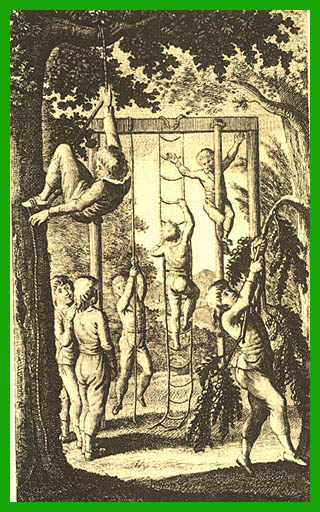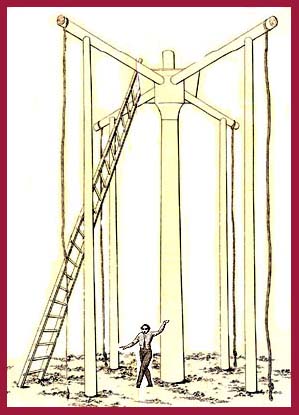The Rope Climb
Competitive Rope Climbing The
Last Traditional Gymnastic
Climbing Event |
| Page 1 | Historical Antecedents of the Sport |
| Page 2 | Description of the Former Event |
| Page 3 | History of Competitions Prior to 1963 |
| Page 4 | Resurrection / Personal Involvement / Elite USA Female Gymnasts |
| Page 5 | The Rope Climb in the Czech Republic by Jiří Tlamsa |
| Page 6 | Records of 2005 Contests in the Czech Republic |
. . .
Rope Climbing in
Gymnastics
.
. .
 Claudius
Galen
(129AD - 216AD) was a Greek born in Pergamum. He became the most famous
doctor of the Roman Empire and is today considered the Father of Sports Medicine.
A prolific writer, his references to gymnastic climbing activities -
specifically the rope - are among the earliest found.
From Gymnastik für die Jugend
(1793) by J. F. GutsMuth : "The ancients were
not unaware of such gymnastic arts. They called it 'scrambling up the
rope' (Greek) or 'ascend by means of
ropes' (Latin). According to old
documents, the ropes were secured to the ground. Galen mentioned it
with the appraisal:
'If anyone climbs a
rope with their hands, as children
exercise in a gymnasium, they become hard and robust' " - De sanitate
tuenda, Lib. II, Cap. 9. (My
imperfect translations from the German, Greek, & Latin). Claudius
Galen
(129AD - 216AD) was a Greek born in Pergamum. He became the most famous
doctor of the Roman Empire and is today considered the Father of Sports Medicine.
A prolific writer, his references to gymnastic climbing activities -
specifically the rope - are among the earliest found.
From Gymnastik für die Jugend
(1793) by J. F. GutsMuth : "The ancients were
not unaware of such gymnastic arts. They called it 'scrambling up the
rope' (Greek) or 'ascend by means of
ropes' (Latin). According to old
documents, the ropes were secured to the ground. Galen mentioned it
with the appraisal:
'If anyone climbs a
rope with their hands, as children
exercise in a gymnasium, they become hard and robust' " - De sanitate
tuenda, Lib. II, Cap. 9. (My
imperfect translations from the German, Greek, & Latin).Ancient Greek or Roman rope athletes, De Arte Gymnastica by Mercurialis 1569 Natural fiber ropes, about 1.5 inches in diameter, were once a mainstay of any gymnasium. The rope and rope ladder may have first been used as instruments of physical education at Basedow's Philanthropinun in 1774, although - as we have seen - the use of ropes as exercise apparatus goes back to the ancient Greeks and Romans. One of the instructors at a philanthropinistic school later designed outdoor apparatus - Climbing Frames - from which ropes and ladders might be hung : Johann GutsMuth, the Grandfather of Gymnastics, formalized the concept of rope climbing as a part of physical education in a classic manual - the first modern work - on gymnastic exercises for youth:  From Gymnastik
fur die Jugend (1793): "This
exercise is more aggressive than the previous [ladders], for there are no steps
for the feet; but all lads who can climb
the pole easily find the rope very similar. The only difficulty is
grasping the rope with the feet for a firm support. Knees and thights
are not useful. By sitting in a chair and clasping the feet about
the knuckles, one sees how to pinch the rope with the feet. The feet
grip the rope between them and hold while the hands move further up
the rope, then grasping the rope and moving the feet up. Nothing more
need be known . . ." From Gymnastik
fur die Jugend (1793): "This
exercise is more aggressive than the previous [ladders], for there are no steps
for the feet; but all lads who can climb
the pole easily find the rope very similar. The only difficulty is
grasping the rope with the feet for a firm support. Knees and thights
are not useful. By sitting in a chair and clasping the feet about
the knuckles, one sees how to pinch the rope with the feet. The feet
grip the rope between them and hold while the hands move further up
the rope, then grasping the rope and moving the feet up. Nothing more
need be known . . ." The First Climbing Frame And then, on to more demanding challenges: "We introduce the problem of climbing the rope through the power of the hands and arms alone, without using the feet. The exercise is hard, but the gymnast no doubt knows how to approach it; for it is reminiscent of the warm-up in which a healthy, fairly strong person can support his weight with one hand without great effort. It comes with trying. They fail at first - each individual hand, especially the left, is too powerless to pull the body up high enough so that the right hand can grasp the rope even higher. But the gymnast supposes at the start that pressing down on the under-hand makes it easier to grasp the rope higher with the other hand. It requires the practice of suspending one's self with one hand, especially the left hand. After considerable practice the goal is reached, and the effect lasts many months." GutsMuth continues: ". . . We've climbed high, the hands lose power. Then what? Should we climb down or fall down? We may not be able to go either up or down. What should we now do? We must hold on until we recover. Good, but how, without using the power of the hands? Each student must reflect upon that and discover how to wrap the rope around themselves so that they may be held comfortably by it. The student presses himself to make the attempt, and after several tries he solves the problem: he climbs to a moderate height. Here he stops. He wraps the rope, using one foot, twice to four times around the other foot, then squeezes the twisted rope together firmly between both feet. The friction between the rope and feet supports the body's entire weight." Finally: "I know some who climb up and down, very lightly. This feat is one of the prettiest and most appropriate for strengthening all the muscles of the breast and arms and hands - it is a true 'touch-stone' of the powers of these members and indicates the increase of these in a very certain manner"   Friedrich
Jahn,
the Father of Gymnastics,
designed huge scaffolds, supporting very long climbing ropes, for
erection in
exercise parks that he called "Turnplatz" in the early 19th century.
Climbing competitions in which speed was the essential criterion were
likely
conducted on a scaffold sporting several ropes, where competittors
raced one another to the top. Friedrich
Jahn,
the Father of Gymnastics,
designed huge scaffolds, supporting very long climbing ropes, for
erection in
exercise parks that he called "Turnplatz" in the early 19th century.
Climbing competitions in which speed was the essential criterion were
likely
conducted on a scaffold sporting several ropes, where competittors
raced one another to the top.Der Vierbaum
Der Einbaum, 1811 Die Deutsche Turnkunst (1816) From Die Deutsche Turnkunst (1816): Jahn states that the most difficult type of cable or rope climbing is, "with both feet and only one hand". In addition, he says, "Also, it is not easy to climb upside down". An 1826 rope climber in America The Competitive Rope Climb , its precedents lost in the detritus of antiquity, became an official event in the first modern Olympic Games (1896), as it had been in the earlier Hellenic Games(1859). Unlike the artistic apparatus specialties, however, rope climbing was discontinued as an Olympic event some years later, in 1932. At the college level in America, residing under the protective mantle of the AAU and the NCAA, it persisted until the early 1960s. At Georgia Tech in 1954 I was introduced to the sport while it was still vibrant and appealing. Spectators loved it at gym meets, for it was both exciting and the only gymnastic event that was judged objectively. But there were two substantial reasons why it met its demise: first, the timing - to tenths of a second - was crudely done by a panel of judges holding stopwatches. And, second, speed climbing was totally unlike the emerging artistry of motion on the other apparatus, where form was a judging criterion. Pity the pommel horse specialist required to race up the rope. Even all-around performers frequently had slow times. Artistic gymnasts referred to rope climbing as a "track and field" activity. After a period of relative dormancy - except for a few die-hards - lasting over thirty years, the sport was quietly resurrected in the Czech Republic. Regional and national competitions on the 8 meter rope have been held there since 1993, and there is considerable enthusiasm among the supporters and participants of this ageless competitive pastime. Welcome back to a great athletic challenge! |